
Table painted amphora with a squat, ovoid body widened at the shoulders. Terracotta colored surface. There is a dent on the surface of the throat, which was probably formed during the formation of the upper sticks of the handles. On the shoulders, on one side, there are two indentations, which may have been left by the potter, checking the dryness of the clay before firing. The outer surface of the amphora is covered with white clay. Remains of painting with red varnish are observed. Ornamental painting – two rather wide strips of varnish on the crowns. Below, on the throat, on two sides, there are rectangles formed by horizontal and vertical stripes of different widths, in which an ornament in the form of a wavy stripe is inscribed. Traces of varnishing were also preserved on the pallet. The handles are decorated with an ornament in the form of two long longitudinal stripes. According to the typology of specialists, the vessel belongs to type “g” of early Miletic table amphorae. It is glued together from fragments and plastered. Restored by DNIM in 2012; 2014. The amphora was discovered in 2011 by D. G. Filimonov in the Tsarychan district, in the vicinity of the village. Kitaygorod, on top of Mount Kalitva in a damaged Scythian burial.

